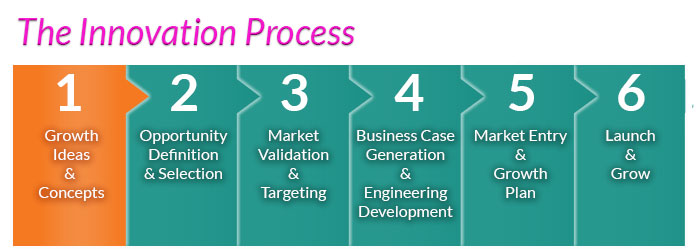Market-Driven Innovation (MDI) is designing, managing, and implementing your innovation process around the needs and wants you capture from your key markets. MDI is not new, but many companies still find it difficult to transform their innovation work from the entrenched, technology-forward approach they have been using to a market-back, or human-centered, approach. Often, their entire business processes have been built around the assets and products they produce, and their go-to-market strategy is based on their historical sales experiences and sets of customers with whom they have the best relationships. This results in the premature commoditization of their value propositions, their most important assets.
Market-Driven Innovation is based on a strict set of principles:
Engineering/technical resourcing decisions are made based on a validated market need and drivers of customer behavior as the foundation for an attractive business case.
Organizational focus is achieved through understanding market segments (sets of customers who are similarly motivated) and targeting the most attractive segments for growth.
A cross-functional team approach where marketing, technical, and sales all contribute to the growth initiative together, and thus are aligned on the strategy.
Accelerated ramp-up occurs after launch from greater operational knowledge of the market.
Technology development is accelerated because better design specifications of a targeted set of customers are captured from the onset of development.
All are driven by business leaders who make resource allocation decisions consistent with the strategic direction of the business, and link development to the marketing process.

Market-Driven Innovation begins with a business oriented toward targeted markets. These markets define strategy, which informs resource allocations—especially those resources dedicated to the innovation process. In this context, we define innovation as the creation of value, and Market-Driven Innovation as placing emphasis on the following:
- The choices a business makes regarding how products go to market
- How the business positions itself and its products in the markets they proactively choose to serve
- The nature of the business's product improvements
- The search for new products and services that may more effectively meet the emerging needs of customers in targeted markets
The Innovation Process Starts with Specific Markets You Choose to Target
Identifying these target markets is core to Market-Driven Innovation. Understanding what drives market growth, what factors contribute to the major unmet needs of the key market players, and how these market players define value are the bases for generating growth ideas and concepts straight from the market. These ideas are the genesis of the innovation process. The more market-backed concepts a business has, the greater the opportunities are for successful growth.
The extent to which you really know your target markets and can identify and deliver solutions that address emerging consumer needs determines our growth and profitability, shareholder value, and employee motivation. Knowing your target markets enables you to
- Design, communicate, and deliver more robust value propositions aimed at specific market segments
- Capture more of the value you provide, because you can measure the value and make strategic pricing decisions that are consistent with your marketing strategy
- More effectively apply your resources in the places where they bring value
- Develop and bring new offerings to the market faster, because you know what the market values and can use these values to inform how you deliver offerings
- Evaluate new markets and identify where you can bring your newly-charged value propositions and offerings
These elements of business design, when generated from a market-back learning model, form the basis for a market-driven organization.
Provide business management with facts, arising from direct contact with the marketplace, that help management decide which concepts merit resourcing.
Balance depth and speed within this disciplined approach by using an organized set of activities.
Enable cross-functional teams to develop common understanding, common direction, and shared values throughout the innovation cycle.
Enhance chance of success.
Voice of the Customer Learning—A Required Competency

Voice of the Customer (VOC), when captured early and implemented within business operations, is an essential component to creating and delivering value within the growth process, and is critical to Market-Driven Innovation.
Learn customers' desired outcomes—what they want to happen—to help them become more successful.
Get to fact-based and data-driven information that can be translated into offering features that address the customers' desired outcomes.
Clearly identify the benefits the customers will receive and thus the discrete value they will place on an effective solution for them.
Be equally understood by both marketing and technical teams, with an aligned sense of the relationship to strategy and core competencies.
VOC is the work you do and do well before you even think of applying technical resources to do product development work. In this regard, you don’t misuse valuable and limited technical capacity. Technical people need to focus on projects that have been market validated, both to focus their limited resources and to provide advanced market specifications that help accelerate the development cycle.
Marketing and Technical Resources Must Be Joined at the Hip
Given the scarcity of technical assets, we use our technical resources and galvanize marketing people simultaneously in order to integrate VOC into our marketing and technical efforts. In this sense, the corresponding teams are better prepared to execute the work identified by and within targeted markets. Resources are aligned from day one of an innovation effort through the launch of a new offering, resulting in faster success, less overall cost, and fewer false starts and lingering stops.
There are three key components of a successful change to market-oriented MDI.
Create the right mindset
Leaders set the agenda
Build the necessary skillset
A common framework for implementing
Provide the best toolset
Fact-based information guides decisions
Each of these components is required to transform a company into a market-driven organization. It’s as straightforward as knowing where you are going, how to get there, and having a map to take you there. We will discuss each of these three success drivers in more detail below.
Leaders Bring the Mindset, Skillset, and Toolset to the Organization
Creating the Right Mindset
Creating the right mindset begins with business leaders. This requires the organization to examine and change how business leaders lead, to define what marketing and technical practitioners should do differently, and most importantly, to identify how each of these groups can work together to build and use a rigorous framework – from concept selection to offering commercialization – to maximize results.
Leadership owns the MDI process. The first two levels in the process, Concept Development/Selection and Market Validation, are the most critical elements. In this model, leadership should not resource technology development until sufficient market evidence and validation provide the basis for such resourcing. Recall, technology resources only work on market-validated concepts.
Market-Driven Innovation Means Judicious Utilization of Technical Resources
Leadership’s ownership of the process means that they
- Demonstrate the value and set expectations
- Focus and align the organization around strategic direction and core capabilities
- Identify and guide the performance requirements necessary to generate the profit results
- Organize people to assure that the right combination of organizational strengths is applied effectively in order to exploit markets
Three crucial questions are answered in market validation and business case development:
- Is there an external basis for believing that the concept has sufficient value to the market to proceed?
- What value proposition can be best validated and set the design basis for development?
- Can we make money from developing and commercializing this value proposition?
Building the Necessary Skillset

The Innovation Model provides the basis for skill development and tool utilization. Each element of the framework requires work specifically designed to help leadership make decisions that move the organization from one element of the model to the next. A short description of the work elements is described below. We have also captured the skillset requirements necessary to implement each element, and have incorporated them into a “Best Practices” Workshop, which is offered as a fully integrated framework model or as a smaller subset that addresses client-specific needs. The skillsets gained and toolsets used to implement this model are best transferred to the organization when they are applied in real-time to chartered projects. Moreover, these practices are best internalized within the organization when a dedicated resource team is available to provide ongoing training and support.
Concept Development and Selection
The “Best Practices” Workshop includes the following activities:
- Developing and characterizing concepts (sometimes called the “Fuzzy Front End”). Idea generation methods are generally well-known; most work well enough to ensure a good set of concepts to evaluate. What we uniquely require is a concept characterization approach that helps the evaluators better understand and choose among several concepts.
- Selecting concepts to validate. The concepts chosen for further pursuit are initiated by a project charter. Project chartering requires the team to clearly define the objectives and goals of the work for which they will declare a scope, identify the key elements of the work, and describe the necessary resources needed to do the work. A project charter is designed to validate the market opportunity for further resourcing, and includes technical and business case development.
Creating the Right Toolset
Opportunity Assessment – A Core Skill for Successful Concept Selection
Market Validation
Once a project has been chartered, a decision (stage gate) is made to resource for development. It includes four key components:
- Validated Market Landscape
- Value Proposition Development
- Competitive Alternative Assessment
- Business Model Evaluation
In the toolset discussed below, we will introduce the Rapid Value Assessment process, which, in the last ten years,has proven to be a useful framework for successfully completing a project charter.
A validated market landscape identifies and characterizes the market spaces in which the concept may be valued. In this context, it provides the basis for demand, and serves as the first real attempt to generate revenue potential. It identifies the key specifiers and influencers in a market space, begins to describe the unmet needs that the new concept (or product) may address, and identifies the key hurdles that must be overcome for a successful and sustainable initiative.
Rapid Value Assessment – A Core Skill for Market Validation
The value proposition is the description of the value your concept will bring to the targeted market, the benefits the market will receive, and how you will get paid for bringing that value. Value position development is the holy grail of marketing. If you learn your value proposition, and it truly brings the market real value, then you can build the remainder of your growth initiative around it. Value propositions must be measurable and actionable.
Hybrid Voice of the Customer
Hybrid Voice of the Customer, or Hybrid VOC, combines the best of the qualitative interview with the core of a quantitative pricing and positioning assessment. Responses from several sets of participants, including key business decision makers and influencers, are captured and analyzed along with key statements as notes to generate a basis for progressing with new product development and commercialization. The analysis generates
- How the concept or new product should be formulated to deliver value to customers
- The price customers would be willing to pay for the concept product
- The share you could expect to receive once in a competitive environment
- Who among potential customers would be the most ready to test and purchase the concept product
There are a few keys to designing a Hybrid VOC interaction:
- Establishing a clear objective: what you need to know for what purpose
- Setting a well-defined scope to include addressable market and competitive environment
- Describing the concept product: what it is and why it can do what it can do
- Identifying possible customer outcomes: what they want to happen in their businesses
- Generating potential product features: what any product must do to address those outcomes
- Defining the competitive environment: the performance options customers have
- Formulating a considered pricing range: enable the customers to select their value level
Benefits of Hybrid VOC
Benefits of Hybrid VOC include
- Speed: A project can be completed within 30 days of initiation
- Thoroughness: The combination brings out more issues and interests than the sum of individual qualitative and quantitative studies
- Positive engagement: Common customer feedback is “The best interaction we have ever had with your firm”
- Alignment: Both marketing and technical are involved in the interactions and learning the same things
- Cost effectiveness: Generally about half the cost of traditional investigations
The Value Proposition - The Foundation of a Successful Growth Initiative
- Competitive assessment in Market-Driven Innovation takes into account in-kind as well as not-in-kind competitive alternatives and in-kind competitive alternatives. In addition to SWOT (strengths, weaknesses, opportunities, and threats) analysis, the skills required to compare alternatives include value-in-use analysis and side-by-side assessment. What most businesses fail to do, however, is obtain the perspective of the specifier. We capture this perspective in the Breakthrough Innovation Hub™, with an external assessment of competitive performance on the offering attributes that are most important to the market. We also uncover how these comparisons may differ by specifier groups—market segments differentiated by importance of offering features.
- Business models are defined by selected customers, how you capture value, your level of strategic control, and the scope of your value proposition. To accelerate and maximize acceptance and value capture, Market-Driven Innovation often requires a new go-to-market strategy. Value-adding chain analysis through to the end user is an important skill set to utilize for business model evaluation.
Innovation May Require a New Business Model
The business case should be determined as early as possible in the innovation process.
- Opportunity modeling using the Breakthrough Innovation Hub™ can provide the necessary basis for understanding the top line potential and the marketing cost for the innovation.
- Financial assessment can be modified to meet your organization’s current financial measuring and reporting system. However, a financial model simulator can be constructed from the VOC data, which enables the team to generate “what if” scenarios to gain a more holistic understanding of the relationship between demand response and financial performance in a competitive environment.
Technical Development
- Effective market validation provides the product developers/designers with a clear and crisp basis for building the necessary design elements into an innovation. At this point, we know the needs (what the market is willing to pay for) and the wants (potential areas of uniqueness). There are no more of the starts and stops that result from the specification changes that mount when we “learn on the fly.” Product developers can use their best practices with the certainty that they are on the right track.
- Because we begin the development process with clear market understanding, we can now bring the key customers into the development cycle early and often. We know their testing protocols and their current standards for the competitive alternative they are using today. We design, we test, we engage the customer to test, and we upgrade. Active parallel processing accelerates the development process and we get to launch faster.
Commercial Launch
- Preparing for product launch includes short-term development of the marketing entry plan and the marketing mix, and the long-term development of a multigenerational plan. These should be done together, since long-term positioning could affect the launch protocol.
- The launch plan includes the target market, the offering positioning (based on the value proposition), the communications strategy and plan, the channel strategy and plan, the pricing strategy, and the implementation plan, all of which are driven by long-term, optimal pricing decisions.
- Multigenerational planning (beyond the launch) includes second- and third-generation offerings, strategy mapping, and a revenue acceleration plan.
- The managing process and control plan are incorporated into the commercial launch to ensure optimum demand creation and delivery.
Providing a Useful Toolset
The toolset necessary to enable effective Market-Driven Innovation consists of integrated qualitative and quantitative data that enable the MDI team to successfully address the critical market questions identified in their chartered project. Two interdependent approaches make up the composite Voice of the Customer, and are designed to answer all the questions necessary to progress through the innovation process previously defined. These two approaches include- A set of qualitative learnings using the Rapid Value Assessment℠ (RVA). A robust RVA should translate concepts into possible value propositions, begin the segmentation process, define the industry structure and dynamics, and expose the relative value vs. competitive alternatives. It also provides the basis for design of the quantitative VOC that follows, once a decision is made to proceed to the business case and technical development stages.
- The quantitative approach in this toolset, the Breakthrough Innovation Hub™, is a powerful and cost-effective methodology to collect the information necessary to build a business case, define the technical development, and prepare the team for commercialization.
Rapid Value Assessment
The Rapid Value Assessment is a disciplined approach to validating market opportunities. The purpose of the assessment is to determine whether a new concept is potentially valuable enough to warrant the commitment resources necessary for application/development and business case evaluation. RVA includes
- Engaging the market to determine the viability of the concept
- Understanding how the value-adding process (value chain) operates
- Developing a compelling value proposition
- Obtaining a first estimate of the potential revenue
- Determining what resources will be required to develop the opportunity for sales and identifying how the development cycle can be shortened
The Breakthrough Innovation Hub™
The Breakthrough Innovation Hub (formerly the Breakthrough Toolkit) is an Excel-based, integrated data-analysis tool that uses a special voice of the customer technique to assess the validity of new product concepts and develop business cases for commercialization or re-positioning of existing offerings.
After a sufficient VOC study has determined
- The target market for the offering;
- The basic structure of the market; and
- The key performance attributes and product features
the Breakthrough Innovation Hub, which is constructed using survey data from an appropriate sample of respondents, provides the business team with a consistent tool to explore the “what if” nature of new business markets. Additionally, it helps companies explore how to enhance their position in existing markets. The Breakthrough Innovation Hub includes a range of interactive screens that enable users to view market information from a multitude of perspectives:
- Identification of performance values significant above and below the mean
- Computation of derived importance (based on correlation)
- Quadrant maps indicating performance, importance, and competitive advantage of offering attributes for all competitors, against all competitors
- Importance maps positioning features by average stated and derived importance
- Value maps with a strategic grid
- Head-to-head analysis comparing products (based on value map analysis)
- Demand and earnings curve diagrams indicating optimum prices
- Price range curves indicating acceptable pricing positions
- Analysis and distributions of the value of feature bundles


